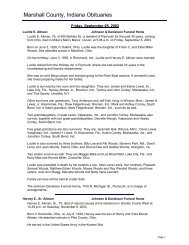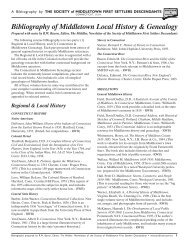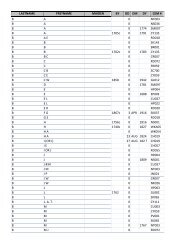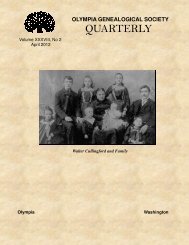Indian population in the United States and Alaska. 1910 - RootsWeb
Indian population in the United States and Alaska. 1910 - RootsWeb
Indian population in the United States and Alaska. 1910 - RootsWeb
You also want an ePaper? Increase the reach of your titles
YUMPU automatically turns print PDFs into web optimized ePapers that Google loves.
160 INDIANS IN THE UNITED STATES.<br />
husb<strong>and</strong>a also of full blood of <strong>the</strong> same tribe, <strong>and</strong> mixed-blood<br />
women of white <strong>and</strong> <strong>Indian</strong> blood, with husb<strong>and</strong>s also of mixed<br />
blood, are considered. It has also been necessary, <strong>in</strong> order to secure<br />
numbers of any size, to make no dist<strong>in</strong>ction of <strong>the</strong> number of years<br />
married, but to <strong>in</strong>clude women married from 1 to 10 years.<br />
TBIBE OB QBOUF.<br />
Cherokee (OHb.)..<br />
Chippewa<br />
Sioiuc(alI)<br />
W. Wash<strong>in</strong>gton<br />
(ma<strong>in</strong>lj Sal&h)..<br />
Apache<br />
Navajo<br />
Yuman,<br />
PEE CENT BEAEINQ<br />
NO CHILDEEN.<br />
Parents<br />
full hlood,<br />
same<br />
tribe.<br />
7.3<br />
10.3<br />
7.6<br />
3.9<br />
7.9<br />
9.3<br />
17. S<br />
Parents<br />
mixed<br />
(white<br />
<strong>and</strong><br />
<strong>Indian</strong>).<br />
AVESAOE NUMBEB<br />
OF CHILDBEN<br />
BOBNE.<br />
Parents<br />
full blood.<br />
tribe.<br />
3.7<br />
3.7<br />
4.1<br />
4.S<br />
3.7<br />
3.5<br />
2.-2<br />
Parents<br />
mixed<br />
(white<br />
<strong>and</strong><br />
<strong>Indian</strong>).<br />
3.5<br />
4.6<br />
4.1<br />
1 Number too small for computation.<br />
PER CENT SUBVrVmo<br />
OF TOTAL<br />
CHILDREN BORNE.<br />
Parents<br />
full blood,<br />
same<br />
tribe.<br />
71.8<br />
64.2<br />
56.4<br />
56.6<br />
69.4<br />
85.9<br />
81.3<br />
Parents<br />
mixed<br />
(white<br />
<strong>and</strong><br />
<strong>Indian</strong>).<br />
82.0<br />
72.7<br />
77.6<br />
, The most strik<strong>in</strong>g po<strong>in</strong>ts brought out by this table are: (1) That<br />
<strong>the</strong> tribes (ma<strong>in</strong>ly belong<strong>in</strong>g to <strong>the</strong> Salishan stock) of western<br />
Waah<strong>in</strong>gton show <strong>the</strong> smallest proportion of sterility, <strong>and</strong> <strong>the</strong> largest<br />
average number of children borne, but at <strong>the</strong> same time <strong>the</strong> next<br />
to <strong>the</strong> smallest proportion surviv<strong>in</strong>g, at least <strong>in</strong> <strong>the</strong> case of <strong>the</strong> full-<br />
bloods; (2) that <strong>the</strong> Yuman tribes of Arizona <strong>and</strong> sou<strong>the</strong>rn California<br />
show <strong>the</strong> largest proportion of steriHly <strong>and</strong> <strong>the</strong> smallest average<br />
number of children borne, but at <strong>the</strong> same time have next to <strong>the</strong><br />
largest proportion surviv<strong>in</strong>g; (3) <strong>the</strong> general agreement between <strong>the</strong><br />
full-bloods of <strong>the</strong> Sioux <strong>and</strong> Cherokee (of Oklahoma only) <strong>in</strong> per<br />
centage of sterility <strong>and</strong> average number of children borne, but<br />
<strong>the</strong>ir difference <strong>in</strong> favor of <strong>the</strong> latter <strong>in</strong> regard to <strong>the</strong> proportion of<br />
children surviv<strong>in</strong>g; <strong>and</strong> (4) that <strong>in</strong> <strong>the</strong> case of <strong>the</strong> Sioux, <strong>the</strong> usual<br />
<strong>in</strong>crease <strong>in</strong> <strong>the</strong> average number of children borne as shown by<br />
<strong>the</strong> mixed-bloods does not occur.<br />
These <strong>and</strong> o<strong>the</strong>r differences apparent on a study of <strong>the</strong> figures<br />
for <strong>in</strong>dividual tribes are <strong>in</strong> many ways suggestive both of economic<br />
<strong>and</strong> possible environmental <strong>in</strong>fluences or of actual differences between<br />
different stocks. It is, for example, possibly significant that<br />
<strong>the</strong> smallest average number of children borne <strong>and</strong> <strong>the</strong> largest pro-<br />
portion of sterility occur <strong>in</strong> <strong>the</strong> arid region of <strong>the</strong> southwest,<br />
whereas <strong>the</strong> largest number of children borne <strong>and</strong> smallest proportion<br />
of sterility are <strong>in</strong> <strong>the</strong> moist coastal regplon of western Wash<strong>in</strong>g-<br />
ton, <strong>the</strong> drier but not arid region of <strong>the</strong> pla<strong>in</strong>s (represented by <strong>the</strong><br />
Sioux <strong>and</strong> Cherokees) fall<strong>in</strong>g between <strong>the</strong>se two extremes. Somewhat<br />
similarly, <strong>the</strong> Southwest shows <strong>the</strong> largest proportion of children<br />
surviv<strong>in</strong>g, <strong>the</strong> region of western Wash<strong>in</strong>gton <strong>the</strong> smallest, with<br />
<strong>the</strong> pla<strong>in</strong>s averag<strong>in</strong>g somewhere <strong>in</strong> between. These statements are<br />
true only, of course, <strong>in</strong> a general way, but it is possible that a hot <strong>and</strong><br />
arid region of ra<strong>the</strong>r deficient food supply, ma<strong>in</strong>ly of vegetable ori-<br />
g<strong>in</strong>, tends to reduce <strong>the</strong> number of children borne, although it is<br />
favorable to <strong>the</strong> survival of those children who are bom; whereas,<br />
an equable, moist area,' of abundant food supply (<strong>in</strong>clud<strong>in</strong>g much<br />
fish, toge<strong>the</strong>r with game <strong>and</strong> vegetable products) may tend to a<br />
greater fertility on <strong>the</strong> part of <strong>the</strong> women, but be at <strong>the</strong> same time<br />
less favorable to <strong>the</strong> survival of <strong>the</strong> larger number of children borne.<br />
Economic factors are, however, of such weight that much more<br />
abundant materials would be needed before def<strong>in</strong>ite conclusions<br />
could be drawn.

















